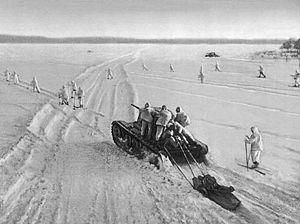December 1941 - Moscow

In mid-November 1941 Field Marshal Fedor von Bock's Army Group Center began the final phase of the German assault on Moscow spearheaded by the Third Panzer Army and Fourth Panzer Army. Some 233,000 men, 1,300 tanks, 1,880 guns and 800 aircraft efficiently split Rokossovsky's 16th Army and Leliushenko's 30th Army as the Germans hammered away at a similar number of Russian men and aircraft but far less guns and tanks; the Russian defenders could only put 1,254 guns and 502 tanks into the field. Though the Germans poured through the gaps torn in the Soviet lines plunging temperatures led to rampant frostbite amongst the ill-equipped German soldiers. German vehicles and weapons ceased to work at negative four degrees Fahrenheit as moving parts and lubricating oil incapable of handling the cold, froze solid. German locomotives broke down in the harsh winter weather and German supply trains running east declined markedly as their payloads of military material proved even more desperately needed then ever.
In spite of the collapsing German logistical network, and the deathly cold, by November 27th German soldiers had crossed the Volga-Moscow Canal and staggered into the outer suburbs of the Soviet capital, purportedly advancing to within 15 miles of the center of Moscow, and, according to legend, within sight of the Kremlin's spires. Soviet General G. K. Zhukov, coordinating Moscow's defense along with Stavka, rushed the 1st Shock Army and 20th Army forward under the cover of heavy close air support and counterattacked on November 28th throwing the Germans back. Further south Heinz Guderian reported on November 20th that fresh front line Siberian divisions were facing his Second Panzer Army and that his motorized divisions were spent. Yet, OKH Chief of Staff Franz Halder refused to allow Guderian to pull units out of the line to replenish and prepare winter positions. Second Panzer Army, arrayed all around the industrial city of Tula south of Moscow pushed on even though 3rd Panzer Division was down to 52 tanks in running order, 4th Panzer was down to 35 operational tanks, 17th Panzer was down to 15 operational tanks and the rest of the Panzer Group was in no better shape. Late in November Guderian's 17th Panzer Division actually fought its way into Kashira on the Oka River - the last natural defensive barrier blocking Guderian's path to Moscow. In response Zhukov ordered in the 1st Guards Cavalry Corps which, along with the Red Army Air Force, pounded into the 17th Panzer Division in an attack launched on November 26th. Though on December 3rd XXIV Panzer Corps cut Tula's rail and road links to Moscow Guderian's Panzer Group could go no further. German divisions existed in name only; infantry companies fought at platoon strength with in some cases only 1 officer and 30 men per company in one front line division.
Meanwhile, on December 1st a reconnaissance patrol from Fourth Panzer Army's 2nd Panzer Division had reached the train station at Khmiki - within only nine of Moscow. Bock however could hardly take advantage of the maneuver as Guderian, Kluge and Hoeppner began halting their attacks. On December 3rd OKH ordered Army Group Center to go over onto the defensive. The Wehrmacht's final spasmodic efforts however quickly became irrelevant as Zhukov counterattacked on December 5th. Zhukov could not have picked a better time to strike; Bock's Army Group was woefully overextended, lacked any prepared defensive positions to fall into, was caught out in the open in temperatures which hovered near a meager five degree Fahrenheit, and thus found itself in an impossible situation entirely created by the German army's supposedly crack leadership. By December 5th Army Group Center faced Soviet Fronts holding 2:1 advantages in manpower, albeit inadequately equipped with the Germans holding superiority in artillery and matching Soviet armored fighting vehicle strength. All told, Zhukov threw some 1.1 million men, about 800 tanks and over 7,600 field guns against Army Group Center. Zhukov sought to first stop, and then, second, crush the twin salients formed by the German Third and Fourth Panzer Groups northwest of Moscow and the German Second Panzer Group southeast of Moscow. Then, third, his Fronts would seek to penetrate Army Group Center's lines and destroy the German Army Group in its entirety. The Western and Kalinin Fronts led the offensive, followed by the South-Western Front on December 6th and the Bryansk Front on December 24th. On December 5th Zhukov's Western Front led by the 1st Shock Army, and also including the 16th, 20th and 30th Army's, pummeled Panzer Group Three and Four in the freezing cold winter weather. The Red Army immediately forced the Germans to give ground and the Red Army Air Force provided extensive air support, enjoying the benefits of flying from well sheltered and provisioned permanent airfields around Moscow. Third Panzer Army was driven back first to Klin, where it temporarily stopped the Red Army on December 7th but then fell back again to the Lama River where it finally halted on December 19th and held its ground until the Red Army launched a new offensive in January. The Fourth Panzer Army and Fourth Army had also retreated, and helped fill in the line to Third Panzer Army's south. With Guderian's Second Panzer Army also driven west, Barbarossa had been defeated; and the Germans had failed to take Moscow.
by Steven Douglas Mercatante



Post new comment